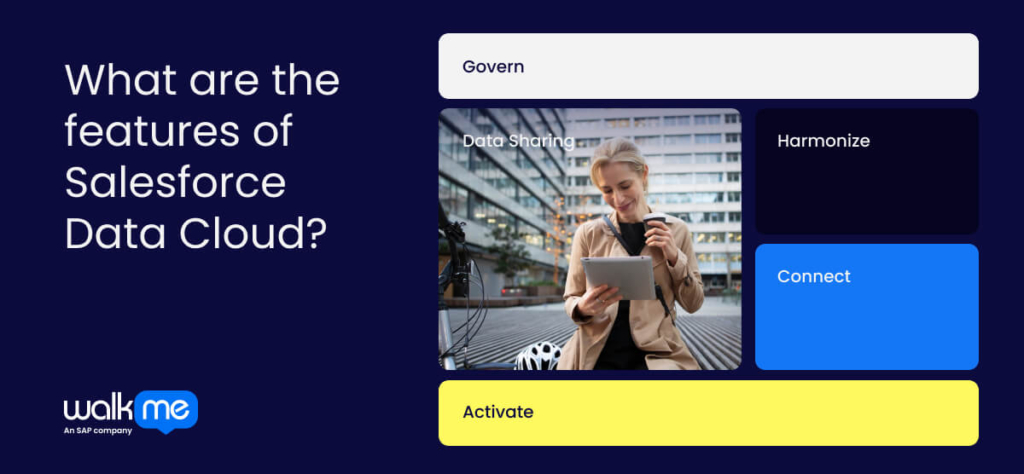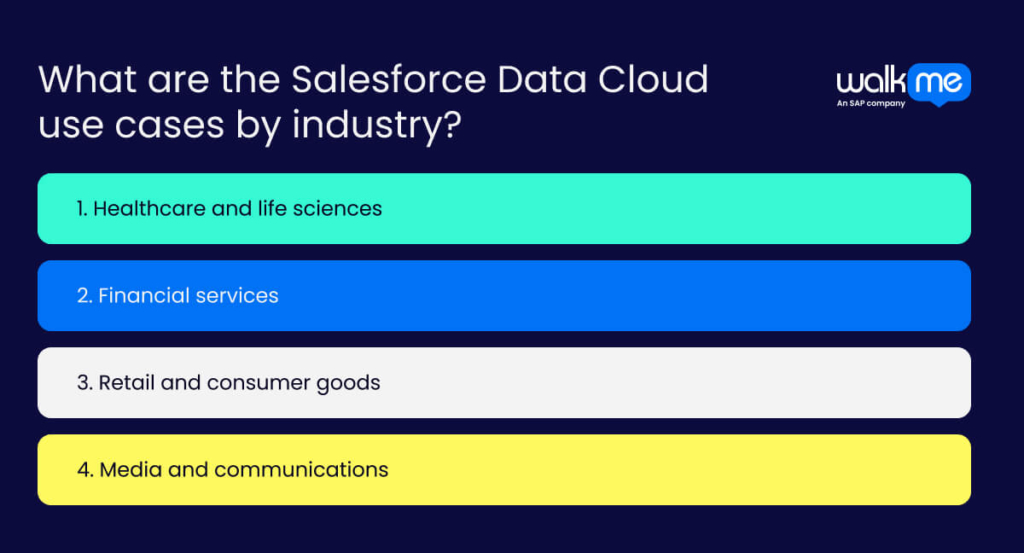Many companies invest in digital transformation to make data-driven decisions, but messy and unreliable data often gets in the way. The real issue is weak data management. Even the best systems fail without clean, organized data.
Leaders must treat data as a strategic asset, not just an IT problem. Most unstructured data, such as emails or customer feedback, requires manual human assistance to be practical. That’s why it’s often overlooked.
Salesforce Data Cloud addresses this by consolidating data from various sources into a single platform. This provides companies with a comprehensive view of their customers, enabling them to make more informed decisions and deliver more personalized experiences.
In this guide, we’ll explore how Salesforce Data Cloud works, its importance, what it offers, and its place in your data strategy.
What is Salesforce Data Cloud?
Salesforce Data Cloud is a powerful enterprise transformation tool that combines data from various sources to provide a unified view of the customer. It works with both structured and unstructured data, acting as a central repository for managing customer information.
Situated within the Salesforce ecosystem, it easily connects with other Salesforce apps and supports low-code tools for faster development. Data Cloud also leverages AI, enabling the use of predictive analytics, intelligent recommendations, and data-driven automation.
With a comprehensive view of the customer, businesses can deliver more personalized experiences, improve marketing efforts, and provide superior service.
As a result, companies can build stronger customer relationships, improve engagement, and increase revenue. By leveraging AI-powered insights and automation, Salesforce Data Cloud enables organizations to achieve their business objectives more effectively.
How does Salesforce Data Cloud work?
Understanding Salesforce Data Cloud functions is vital because it enables businesses to consolidate data from various sources into a single, clear view.
This is how it works in practice:
Data ingestion and unification
Salesforce Data Cloud unifies customer data from multiple sources into a single, accurate profile by ingesting, cleaning, mapping, and resolving duplicate records. This streamlined view enables businesses to organize and analyze information more effectively, power automation, and deliver personalized, targeted experiences that support smarter decision-making.
Profile management and segmentation
Profile management involves creating and updating customer profiles using data from various sources, while segmentation groups these profiles by shared traits, such as interests or behaviors. Together, these tools enable businesses to understand their customers better and connect more effectively with their target audiences. An accurate, organized view of each profile supports a more customer-centric approach.
Activation through the Salesforce ecosystem
As a unified data source, Salesforce Data Cloud powers real-time data sharing across Sales Cloud, Service Cloud, and Marketing Cloud, enabling precise and timely customer engagement. It routes leads to sales, prioritizes support cases, and launches personalized campaigns—all driven by live data. With centralized access and actionable insights, cross-functional teams can collaborate more effectively to deliver a seamless experience across every Salesforce touchpoint.
What are the features of Salesforce Data Cloud?

For companies seeking to improve customer experience, understanding the features of Salesforce Data Cloud is crucial.
These are the Salesforce Data Cloud features you need to be aware of, depending on usage:
Govern
Salesforce Data Cloud’s Govern feature ensures data accuracy, security, and compliance, allowing your business to trust it for AI and other applications. It also helps build a strong, scalable Customer 360 by removing barriers between data systems and improving data control.
It does this through:
- Private Connect: This element creates secure links between Data Cloud and other third-party systems like AWS. This keeps data off the internet and safe from outside threats.
- Native policy governance: This allows organizations to set rules for who can see and use data. These rules are applied across the platform to meet internal and legal standards.
- AI tagging: This feature uses automation to sort data by sensitivity and use. Managing data becomes easier and reduces manual work while keeping sensitive info secure.
Data Sharing
Businesses can make better decisions and enable more personalized experiences through Data Cloud’s Data Sharing feature.
You can do this with:
- Advertising platforms: Help you connect to platforms like Google Ads and LinkedIn, so you can run more targeted and effective campaigns.
- Business applications: By sharing customer data with tools like CRM, marketing, and service platforms, it helps all teams personalize the full customer journey. Data is shared without creating copies, so access is faster and more secure.
- Data lakes and warehouses: Enables connections to your existing systems without needing to move the data. This lets you use your current tools while keeping a full customer view.
Harmonize
Salesforce Data Cloud’s Harmonize feature helps clean and connect data from many sources into one clear format. It removes data silos so teams can easily find and use the same information, saving time.
It offers elements like:
- A unified data model: Brings all the cleaned and connected data together into one clear view that teams can use for reports, planning, and action.
- Identity resolution: Finds and connects data about the same person or company from different places to create one accurate profile.
- Data transformations: Changes and organizes data from many systems into a shared format that fits Salesforce’s Customer 360 model.
Connect
By way of its Connect feature, Salesforce Data Cloud helps businesses bring data together from many places, even if it’s in different formats.
This is possible through:
- Structured and Unstructured Data: Data Cloud brings together all types of data for a full customer view. It matches and cleans data from different sources.
- Zero Copy Integration: This feature allows you to use data without copying it, so it’s always current. Employees can also access data in real time without moving it into Salesforce. This lowers storage costs and keeps data in place for compliance.
- Connectors: Salesforce Connectors link to many systems with ease. Many need no code to set up. Some include ready-made bundles that fit Salesforce’s format.
Activate
Salesforce Data Cloud’s Activate feature helps turn data into real action.
It does this in three main ways:
- Segmentation: Data Cloud can group customers based on things like behavior, location, or interests. These segments help you send personalized messages and offers, making outreach more effective
- Data Cloud-automated flows: These flows use live data to start actions automatically. For example, if a data point changes, the system can update a record, send a message, or start a business process right away. This keeps your systems up to date and responsive in real time.
- Predictive models: With AI, Data Cloud can guess what a customer might do next. You can use these predictions to plan better, offer targeted deals, or give more helpful support.
What are the Salesforce Data Cloud use cases by industry?

It is essential to understand how to effectively utilize Salesforce Data Cloud in practice to achieve the best results. By understanding the different ways to apply Data Cloud, businesses can combine their data more effectively.
This helps them create personalized experiences for customers and enhance business resilience.
Here are valuable ways to use Salesforce Data Cloud, depending on your industry:
Healthcare and life sciences
Salesforce Data Cloud can help healthcare and life sciences by unifying patient data from EHRs, portals, and claims into one view. For instance, in drug development, it speeds research and improves outcomes. MedTech companies can use it to personalize products and deliver better patient experiences through data-driven insights.
Financial services
Financial institutions can benefit from Data Cloud as it can use customer data to personalize services, enhance engagement, and make better decisions. For example, with Data Cloud’s AI features, this type of industry can predict future needs and risks. Companies can also protect sensitive data and meet regulatory reporting requirements more efficiently.
Retail and consumer goods
Salesforce Data Cloud enables retailers to consolidate customer data from various sources, providing a comprehensive view of each shopper. This allows for more personalized marketing, product recommendations, and pricing.
For instance, Data Cloud makes it easy to group customers by things like age, past purchases, and shopping habits. This helps retailers send more relevant offers and messages, leading to better customer care.
Media and communications
Media companies can deliver personalized content, improve ad sales, and run smoother operations through Data Cloud. For example, the platform can automate tasks like content creation, sharing, and reporting, saving time and effort.
Media Cloud, built on Data Cloud, also offers a flexible, all-in-one platform. This allows media organizations to grow, adapt quickly to market changes, and stay competitive in a fast-moving industry.
Turning understanding into strategy with Salesforce Data Cloud
Salesforce Data Cloud is a powerful tool for bringing together, managing, and using business data at scale. For IT leaders, it stands out for its flexible setup, built-in security, and real-time connections to Salesforce apps. But to get the most value, it must fit well with your current systems, data rules, and long-term goals.
It can be a smart investment, but only if your business is ready to show clear results. With strong use cases, you can stay on track with your goals and see the benefits of having a single view of the customer. If you’re exploring workplace transformation, Salesforce Data Cloud can be a way to change how your business uses customer insights.
FAQs
Salesforce Data Cloud offers businesses a comprehensive view of customer data by integrating multiple data sources. It removes data silos, supports real-time processing, and helps teams personalize experiences and make smarter decisions with AI.
Implementing Salesforce Data Cloud can be a challenging task. Teams must manage data quality, connect old systems, and control costs. Security, user adoption, and workflow setup are also key challenges.
Salesforce Data Cloud is the new name for what was previously known as Salesforce Genie. In February 2023, Salesforce changed the name but retained the platform. Both names refer to the same real-time data platform.

